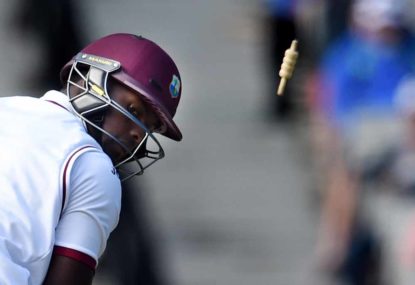Cricket Australia backflips on Bartlett's county stint, Stoinis slams century to break IPL drought
Xavier Bartlett has been permission to extend his cricketing education with a spell of T20s in England, playing in the Blast competition for Kent…

As a medium-fast bowler of some repute, in my mind at least, I was spared the phenomenon known as reverse swing.
In my career in the early 70s, contending with ‘in’ and ‘out’ swing and the vagaries of ‘seaming’ was sufficiently complicated. I wasn’t even aware of reverse swing. I can’t remember Alan McGilvray ever mentioning it.
What is this mystical reverse swing that some cricket commentators frequently talk about yet have difficulty in giving a lucid explanation to?
Of the current crop of television commentators, excellent cricketers in their own right, half of them avoid commenting on this phenomenon.
The other half however, interlace expert comments with terms such as ‘reverse swing’ and ‘tailing-in’ until the poor viewer is on the verge of changing the channel to the golf.
I first recall the expression ‘reverse swing’ used by Ian Botham when commentating in England in the early 90s. If memory serves, his comments were about the great Pakistani bowler Wasim Akram, who apparently was one of the ‘pioneers’ of reverse swing bowling.
The ball goes through two phases when bowled. The first is the time the ball travels through the air. This is the window of swing.
The second is when the ball hits the ground, taking-off in an unpredictable path depending on the amount of ‘seam’ that makes contact with the pitch.
This is when ‘seaming’ occurs. The ‘seam’ is quaintly referred to as the ‘rope’ by some of northern climes.
To induce swing, one side of the ball is polished. The other is not.
Physics dictates that the smooth side of the ball will encounter less resistance when travelling through the air than the rough side, when the ball is bowled with the seam in an upright position.
When trying to swing the ball it is important to give the ball air. That is, to pitch it up to just short of a full length.
It follows that the longer the ball is in the air the greater the chance it will swing. For a right-arm bowler to bowl an out-swinger to a right–handed batsman he should hold the ball with an upright seam between first and second fingers, with the shiny side of the ball on the right.
When travelling through the air, the rough side of the ball will be slowed by the air (friction) causing the ball to change direction towards the left or away from a right handed batsman. The opposite works for an in-swinger.
When the ball hits the pitch the ‘seam’ comes into play. If the seam is upright it will move off the pitch in line with the swing trajectory. If upright but slightly tilted to left or right (through position of the two gripping fingers) the trajectory of the ball, after hitting the pitch, will vary.
This is seaming. It is less than a precise science because depending on time in the air, speed of the ball, and the condition of the pitch at the point of impact, anything can and does happen.
But back to swinging. Reverse swing apparently occurs when the ball decides to defy the laws of physics and do the opposite to what it should do.
For example, in the case of the out-swinger which moves right to left across the right-handed batsman because of the unpolished/polished, upright seam position of the ball, reverse swing is accomplished, when, with the ball position the same, it moves left to right across the batsman.
I am at a loss to understand how a bowler can be credited with reverse swing when it seems to me he is doing his best to bowl an in or out swinger. This reeks of mysticism.
I believe that the vagaries of seaming are responsible for the so-called ‘reverse swing’. I believe it is not swing per se but rather the unpredictable direction it takes after it has hit the deck.
Perhaps one last job for the myth-busters?